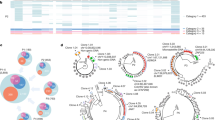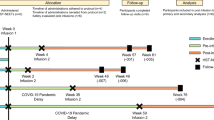Abstract
An HIV-1-seropositive volunteer was infused with an expanded autologous cytotoxic T lymphocyte (CTL) clone directed against the HIV-1 net protein. This clone was adoptively transferred to determine whether supplementing CTL activity could reduce viral load or improve clinical course. Unexpectedly, infusion was followed by a decline in circulating CD4+ T cells and a rise in viral load. Some of the HIV isolates obtained from the plasma or CD4+ cells of the patient were lacking the nef epitope. These results suggest that active CTL selection of viral variants could contribute to the pathogenesis of AIDS and that clinical progression can occur despite high levels of circulating HIV-1-specific CTLs.
This is a preview of subscription content, access via your institution
Access options
Subscribe to this journal
Receive 12 print issues and online access
209,00 € per year
only 17,42 € per issue
Buy this article
- Purchase on SpringerLink
- Instant access to full article PDF
Prices may be subject to local taxes which are calculated during checkout
Similar content being viewed by others
References
Green, W.R., Green, K.A. & Crassi, K.M. Adoptive transfer of polyclonal and cloned cytolytic T lymphocytes (CTL) specific for mouse AIDS-associated tumors is effective in preserving CTL responses: a measure of protection against LP-BM5 retrovirus-induced immunodeficiency. J. Virol. 68, 4679–4684 (1994).
Slobod, K.S. & Allen, J.E. Parainfluenza type 1 virus-infected cells are killed by both CD8+ and CD4+ cytotoxic T cell precursors. Clin. exp. Immun. 93, 363–369 (1993).
Kyburz, D., Speiser, D.E., Aebischer, T., Hengartner, H. & Zinkernagel, R.M. Virus-specific cytotoxic T cell-mediated lysis of lymphocytes in vitro and in vivo. J. Immun. 150, 5051–5058 (1993).
Del Val, M. et al. Protection against lethal cytomegalovirus infection by a recombinant vaccine containing a single nonameric T-cell epitope. J. Virol. 65, 3641–3646 (1991).
Kast, W.M. et al. Protection against lethal Sendai virus infection by in vivo priming of virus-specific cytotoxic T lymphocytes with a free synthetic pep-tide. Proc. natn. Acad. Sci. U.S.A. 88, 2283–2287 (1991).
Oldstone, M.B. et al. Vaccination to prevent persistent viral infection. J. Virol. 67, 4372–4378 (1993).
Whitton, J.L., Sheng, N., Oldstone, M.B. & McKee, T.A. A string-of-beads vaccine, comprising linked minigenes, confers protection from lethal-dose virus challenge. J. Virol. 67, 348–352 (1993).
Oehen, S., Waldner, H., Kundig, T.M., Hengartner, H. & Zinkernagel, R.M. Antivirally protective cytotoxic T cell memory to lymphocytic choriomenin-gitis virus is governed by persisting antigen. J. exp. Med. 176, 1273–1281 (1992).
Binder, D. & Kundig, T.M. Antiviral protection by CD8+ versus CD4+ T cells. J. Immun. 146, 4301–4307 (1991).
Dillon, S.B. et al. Induction of protective class I MHC-restricted CTL in mice by a recombinant influenza vaccine in aluminium hydroxide adjuvant. Vaccine 10, 309–318 (1992).
Ruprecht, R.M. et al. Vaccination with a live retrovirus: The nature of the protective immune response. Proc. natn. Acad. Sci. U.S.A. 87, 5558–5562 (1990).
Koup, R.A. et al. Temporal association of cellular immune responses with the initial control of viremia in primary H1V-1 syndrome. J. Virol. 68, 4550–4559 (1994).
Yasutomi, Y., Reimann, K., Lord, C., Miller, M. & Letvin, N. Simian immunodeficiency virus-specific CD8+ lymphocyte response in acutely infected rhesus monkeys. J. Virol. 67, 1707–1711 (1993).
Pircher, H. et al., Viral escape by selection of cytotoxic T cell-resistant virus variants in vivo. Nature 346, 629–633 (1990).
Jacobson, S., Shida, H., McFarlin, D.E., Fauci, A.S. & Koenig, S. Circulating HTLV-1 pX-specific CD8+ cytotoxic T lymphocytes in patients with HTLV-1 associated neurologic disease. Nature 348, 245–248 (1990).
Plata, F. et al. AIDS virus-specific cytotoxic T lymphocytes in lung disorders. Nature 328, 348–351 (1988).
Walker, B.D. et al. HlV-specific cytotoxic T lymphocytes in seropositive individuals. Nature 328, 245–248 (1987).
Koenig, S. et al. Group specific, major histocompatibility complex class I restricted cytotoxic responses to human immunodeficiency virus-1 envelope proteins by cloned peripheral blood T cells from an HIV-infected individual. Proc. natn. Acad. Sci. U.S.A. 85, 8638–8642 (1988).
Walker, B.D. et al. HIV-1 reverse transcriptase is a target for cytotoxic T lymphocytes in infected individuals. Science 240, 64–66 (1988).
Koup, R.A. et al. Detection of major histocompatibility complex class I-re-stricted, HIV-specific T lymphocytes in the blood of infected hemophiliacs. Blood 73, 1909–1914 (1989).
Koenig, S. et al. Mapping the fine specificity of a cytolytic T cell response to HIV-1 nef protein. J. Immun. 145, 127–135 (1990).
Riviere, Y. et al. Human immunodeficiency virus-specific cytotoxic responses of seropositive individuals: Distinct types of effector cells mediate killing of targets expressing gag and env proteins. J. Virol. 63, 2270–2277 (1989).
Hoffenbach, A. et al. Unusually high frequencies of HIV-specific cytotoxic T lymphocytes in humans. J. Immun. 142, 452–462 (1989).
Culmann, B. et al. Six epitopes reacting with human cytotoxic CD8+ T cells in the central region of the HIV-1 nef protein. J. Immun. 146, 1560–1565 (1991).
Gotch, F.M., Nixon, D.F., Alp, N., McMichael, A.J. & Borysiewicz, L.K. High frequency of memory and effector gag specific T lymphocytes in HIV seropositive individuals. Int. Immun. (2), 707–712 (1990).
Lamhamedi-Cherradi, S. et al. Qualitative and quantitative analysis of human cytotoxic T lymphocyte responses to HIV-1 proteins. AIDS 6, 1249–1258 (1992).
Carmichael, A., Kin, X., Sissons, P. & Borysiewicz, L. Quantitative analysis of the human immunodeficiency virus type 1 (HlV-1)-specific cytotoxic T lymphocyte (CTL) response at different stages of HIV-1 infection: Differential CTL responses to HIV-1 and Epstein-Barr virus in late disease. J. exp. Med. 177, 249–256 (1991).
Wong, R.A., Alexander, R.B., Puri, R.K. & Rosenberg, S.A. In vivo proliferation of adoptively transferred tumor-infiltrating lymphocytes in mice. J. 1mmunother. 10, 120–130 (1991).
Phillips, R.E. et al. Human immunodeficiency virus genetic variation that can escape cytotoxic T cell recognition. Nature 354, 453–459 (1990).
Myers, G. HIV Sequence Database (Los Alamos National Library, Los Alamos, New Mexico, 1988).
Daniel, M.D., Kirchhoff, F., Szajak, S.C., Sehgal, P.K. & Desrosiers, R.C. Protective effects of a live attenuated SIV vaccine with a deletion in the nef gene. Science 258, 1938–1941 (1992).
Riddell, S.R. et al. Restoration of viral immunity in immunodeficient humans by the adoptive transfer of T cell clones. Science 257, 238–241 (1992).
Johnson, R.P., Trocha, A., Buchanan, T.M. & Walker, B. Recognition of a high conserved region of human immunodeficiency virus type 1 gp120 by an HLA-Cw4-restricted cytotoxic T lymphocyte clone. J. exp. Med. 175, 961–971 (1992).
Dai, L.C., West, K., Littaua, R., Takahashi, K. & Ennis, F.A. Mutation of human immunodeficiency virus type 1 at amino acid 585 on gp41 results in loss of killing by CD8+ A24-restricted cytotoxic T lymphocytes. J. Virol. 66, 3151–3154 (1992).
Couillin, I. et al. Impaired cytotoxic T lymphocyte recognition due to genetic variations in the main immunogenic region of the human immunodeficiency virus 1 nef protein. J. exp. Med. 180, 1129–1134 (1994).
Chen, Z.W., Kou, Z.C., Shen, L., Reimann, K.A. & Letvin, N.L. Conserved T cell receptor repertoire in simian immunodeficiency virus-infected rhesus monkeys. J. Immun. 151, 2177–2187 (1993).
Ho, M. et al. A phase I study of adoptive transfer of autologous CD8+ T lymphocytes in patients with acquired immunodeficiency syndrome (AIDS)-related complex or AIDS. Blood 81, 2093–2101 (1993).
Folks, T. et al. Biological and Biochemical Characterization of a Cloned leu 3 Cell Surviving Infection with the AIDS Retrovirus. J. exp. Med. 164, 280–290 (1986).
Pantaleo, G. et al. HIV infection is active and progressive in lymphoid tissue during the clinically latent stage of disease. Nature 362, 355–358 (1993).
Sambrook, J., Fritsch, E.F. & Maniatis, T. Molecular Cloning, A Laboratory Manual, 2nd edn (Cold Spring Harbor Laboratory Press, Cold Spring Harbor, New York, 1989).
Author information
Authors and Affiliations
Rights and permissions
About this article
Cite this article
Koenig, S., Conley, A., Brewah, Y. et al. Transfer of HIV-1-specific cytotoxic T lymphocytes to an AIDS patient leads to selection for mutant HIV variants and subsequent disease progression. Nat Med 1, 330–336 (1995). https://doi.org/10.1038/nm0495-330
Received:
Accepted:
Issue Date:
DOI: https://doi.org/10.1038/nm0495-330
This article is cited by
-
Immune escape mutations in HIV-1 controllers in the Brazilian Amazon region
BMC Infectious Diseases (2020)
-
Next-generation sequencing analyses of the emergence and maintenance of mutations in CTL epitopes in HIV controllers with differential viremia control
Retrovirology (2018)
-
Engineering T Cells to Functionally Cure HIV-1 Infection
Molecular Therapy (2015)
-
Leveraging Cancer Therapeutics for the HIV Cure Agenda: Current Status and Future Directions
Drugs (2015)
-
Low level of HIV-1 evolution after transmission from mother to child
Scientific Reports (2014)



